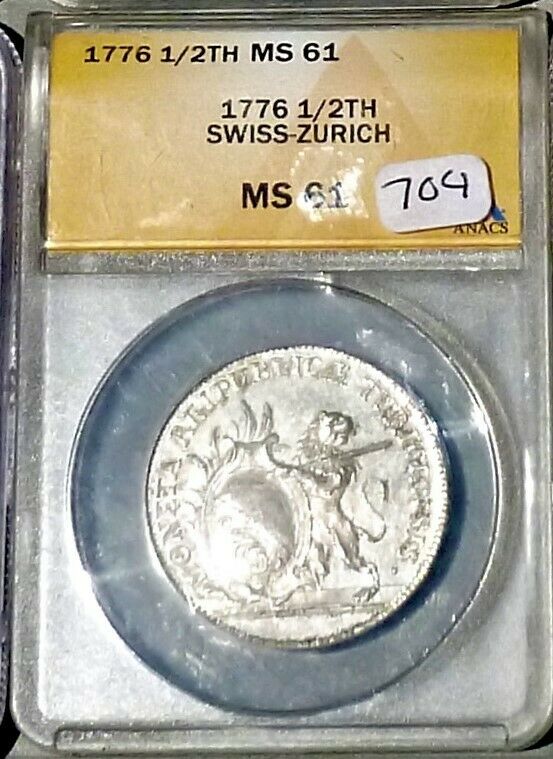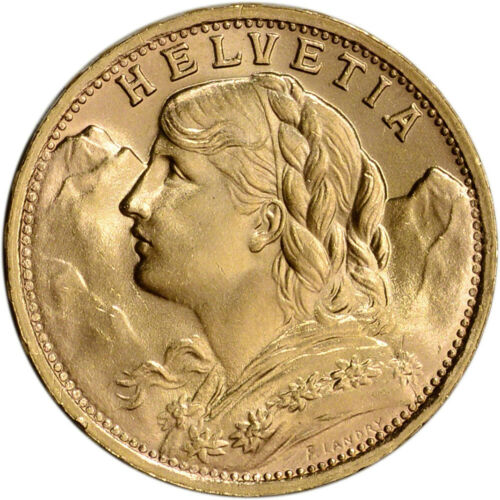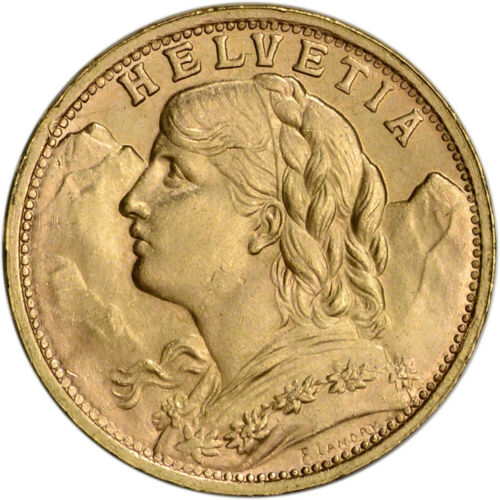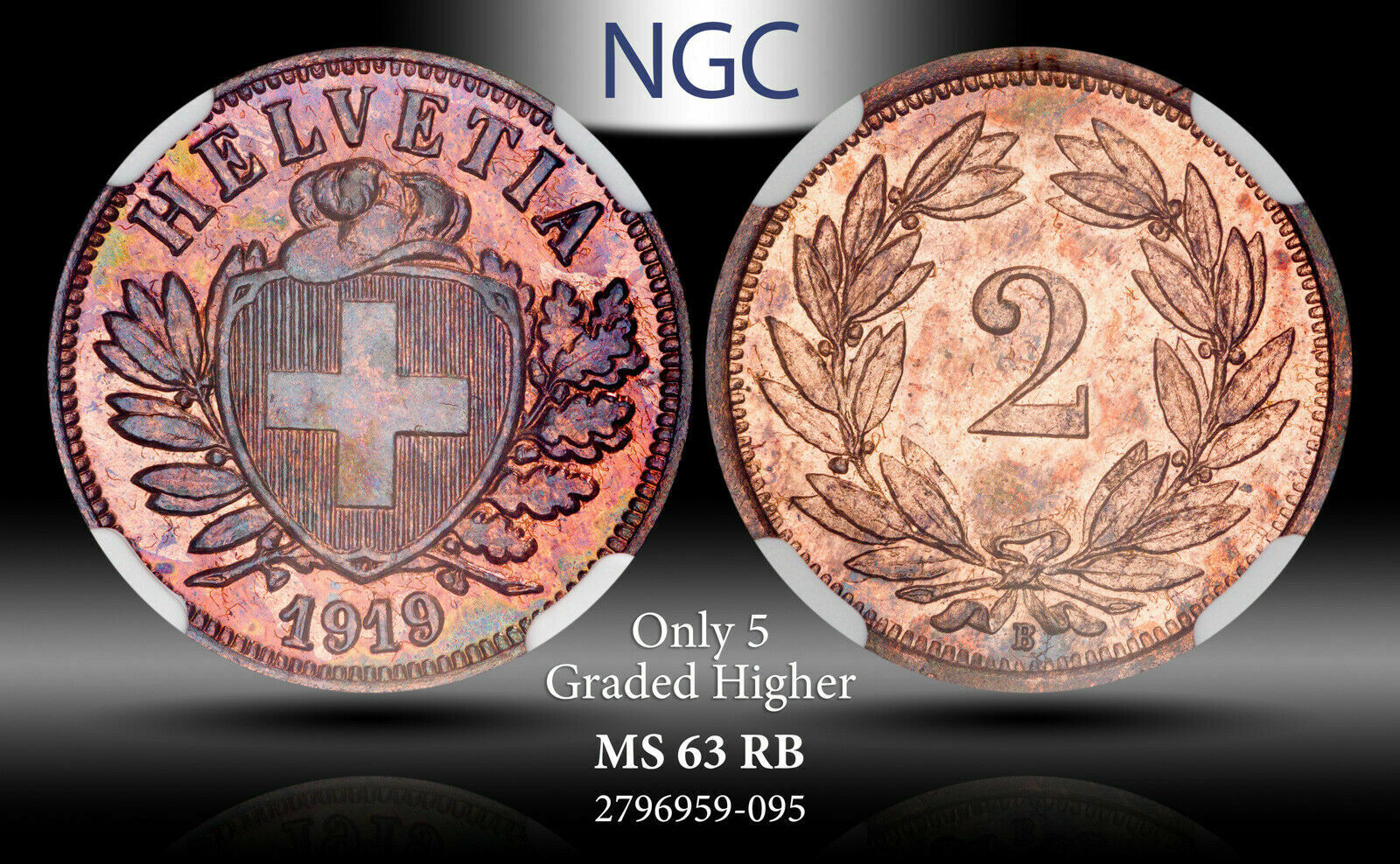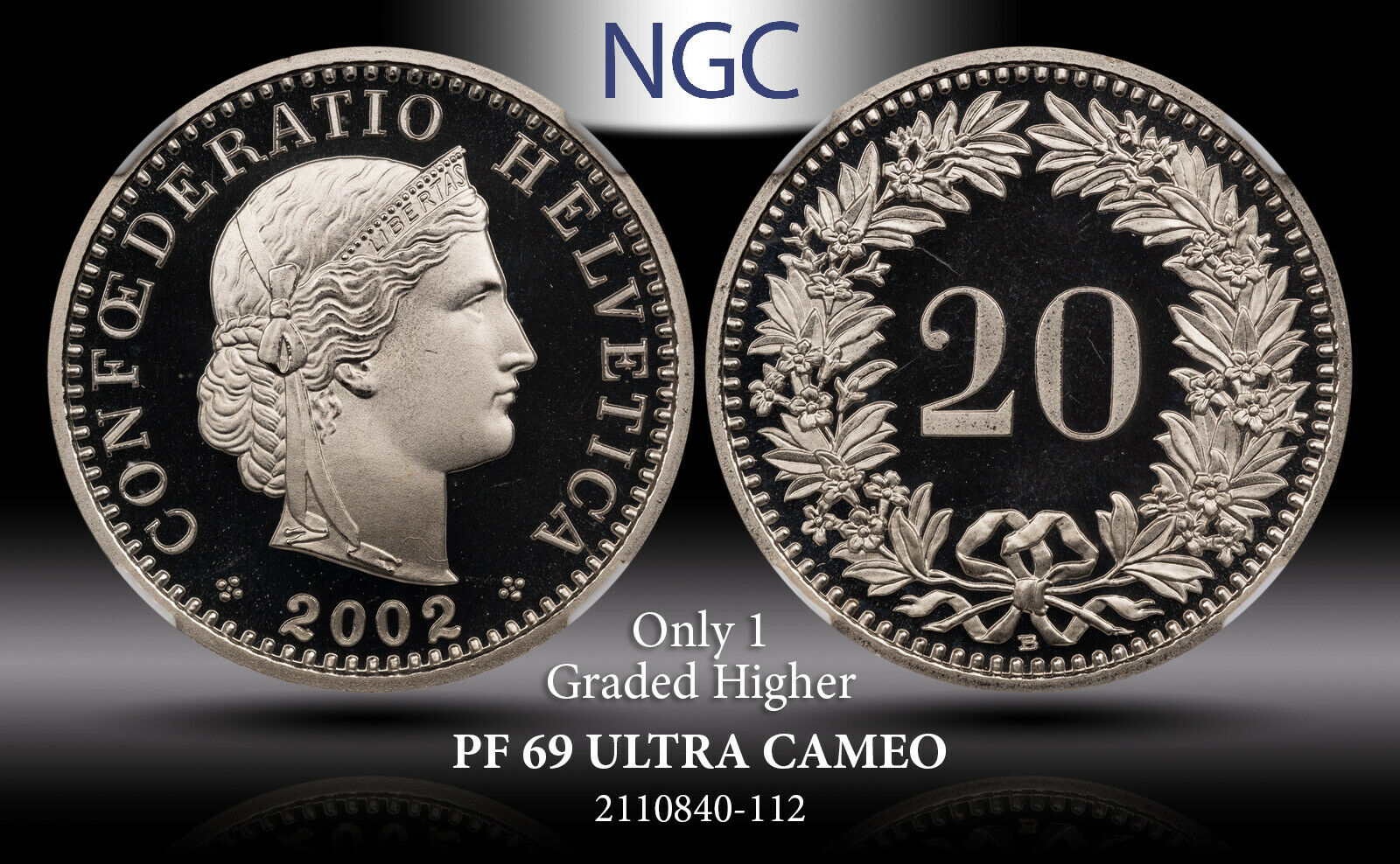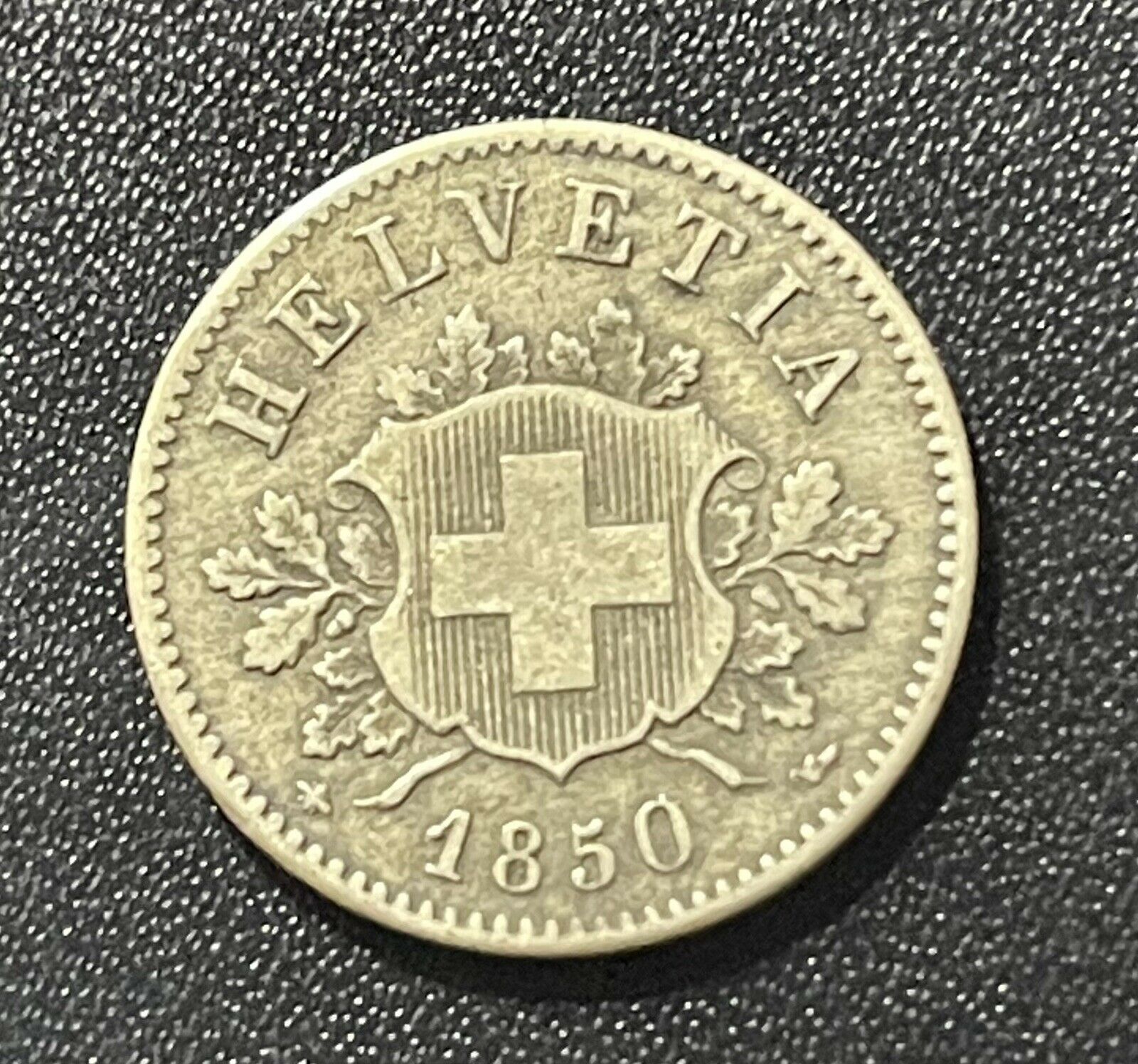-40%
1776 SWITZERLAND Swiss Canton of ZURICH ANACS MS61 1/2 Thaler Silver Coin
$ 261.36
- Description
- Size Guide
Description
Recently an uncertified circulated example of this exact coin sold oj eBay for 18.00This example is far superior with a lower price.
Authentic Coin of:
Switzerland
. Swiss Canton of Zurich
1776
Silver 1/2 Taler 33mm (13.05 grams)
Reference: KM# 162, HMZ# 2-1165
MONETA REIPUBLICÆ TURICENSIS., Oval arms of Zurich within sprigs, supported by rampant lion at right.
IUSTITIA ET CONCORDIA 1776., Crossed cornucopias within cartouche.
The
Canton of Zürich
is a Swiss canton in the northeastern part of the country. With a population of 1,520,968 (as of 31 December 2018), it is the most populous canton in the country. Its capital is the city of Zürich. The official language is German. The local Swiss German dialect, called
Züritüütsch
, is commonly spoken. In English the name of the canton and its capital is often written without an umlaut.
Early history
The prehistoric pile dwellings around Zürichsee comprise 11 of total 56 prehistoric pile dwellings around the Alps in Switzerland, that are located around Lake Zürich in the cantons of Schwyz, St. Gallen and Zürich. Located on the shore of Lake Zürich, there are Freienbach-Hurden Rosshorn, Freienbach-Hurden Seefeld, Rapperswil-Jona/Hombrechtikon-Feldbach, Rapperswil-Jona-Technikum, Erlenbach-Winkel, Meilen-Rorenhaab, Wädenswil-Vorder Au, Zürich-Enge Alpenquai, Grosser Hafner and Kleiner Hafner. Because the lake has grown in size over time, the original piles are now around 4 metres (13 ft) to 7 metres (23 ft) under the water level of 406 metres (1,332 ft). Also on the small area of about 40 square kilometres (15 sq mi) around Zürichsee, there also the settlements Greifensee-Storen/Wildsberg on
Greifensee
and Wetzikon-Robenhausen on
Pfäffikersee
lakeshore. As well as being part of the 56 Swiss sites of the UNESCO World Heritage Site, each of these 11 prehistoric pile dwellings is also listed as a
Class object
in the Swiss inventory of cultural property of national and regional significance.
Zurihgauuia
(
Zürichgau
) was a subdivision of
Turgowe
(Thurgau) in the Duchy of Alamannia, consisting roughly of the territory between Reuss and Töss. From the 740s, substantial portions of Zürichgau were owned by the Abbey of St. Gall. In c. 760, an administrative re-organisation under counts Ruthard and Warin exempted the castle town of Zürich from comital rule. A county of Zürichgau was established under Louis the Pious, for a count Ruadker, in 820. Zürichgau (
Zurichgeuue
) remained a nominally separate territory in the later 9th century but was often ruled by the same count as Thurgau. In 915, Zürichgau together with Thurgau fell to the Bucharding dukes of Swabia. In the late 10th century, the county of Zürich was ruled by the Nellenburger, and during 1077-1172 by the Lenzburger. By the 13th century, Zürichgau was divided between the Habsburgs and the Kyburger, who held the territory west and east of Lake Zürich, respectively.
City state
The territory of the canton of Zürich corresponds to the lands acquired by the city of Zürich after it became
reichsfrei
in 1218. Zürich pursued a policy of aggressive territorial expansion especially during the century following the revolution of the guilds in 1336. Zürich joined the Swiss Confederacy in 1351.
Zürich claimed and lost the Toggenburg in the Old Zürich War of the 1440s. The northern parts up to the river Rhine came to the canton after the city of Zürich purchased Winterthur from the Habsburgs in 1468. In 1651, Zürich purchased Rafzerfeld from the counts of Sulz. At this point, almost all of the territory of the modern canton (as well as some territories beyond its modern borders) was owned by Zürich; exceptions include Wülflingen (acquired 1760), Buch (acquired 1761), Dietikon, which was a condominium, and Rheinau (owned by Rheinau Abbey).
In the 18th century, the "inner bailiwicks" (
Innere Vogteien
) were under direct administration of city officials, while the "outer bailiwicks" (
Äussere Vogteien
) were ruled by the reeves of Kyburg, Grüningen, Greifensee, Eglisau, Regensberg, Andelfingen, Wädenswil, and Knonau. The city of Winterthur was nominally subject to Zürich but retained far-reaching autonomy.
Zürichgau
, the name of the medieval
pagus
, was in use for the territories of the city of Zürich during the 15th and 16th century; the term
canton
(
Kanton
) gradually entered use in the 16th century, but
Zürichgau
remained widely used well into the 19th century (becoming obsolescent after the formation of the modern canton in 1831).
Under the short-lived Helvetic Republic (1798-1803), the
canton of Zürich
became a purely administrative division. In 1803, some former possessions of Zürich to the west gained independence as part of the Canton of Aargau. In 1804 the Kantonspolizei Zürich was established as
Landjäger-Corps des Kantons Zürich
.
Modern canton
A cantonal constitution was drawn up in 1814 and replaced in 1831 by a radical-liberal constitution. The Züriputsch, an armed uprising of the conservative rural population against the radical-liberal order, led to the dissolution of the cantonal government, and a provisional conservative government was installed by colonel Paul Carl Eduard Ziegler. Under the threat of intervention of the other radical-liberal cantons of the Confederacy, the provisional government declared that the 1831 constitution would remain in effect. In a tumultuous session on 9 September 1839, the cantonal parliament declared its dissolution In the so-called
Septemberregime
, the newly elected cantonal government replaced all cantonal officials with conservatives, but it was again ousted by a radical-liberal election victory in 1844.
Alfred Escher was a member of the new cantonal parliament of 1844; he was elected to the cantonal government in 1848 and later in the same year into the first National Council under the new federal constitution. The radical-liberal era of 1844-1868 was dominated by the so-called
System Escher
, a network of liberal politicians and industrialists built by Alfred Escher. Escher governed the canton almost in monarchical fashion, and was popularly dubbed
Alfred I.
or
Tsar of All Zürich
. Escher controlled all cantonal institutions, at first with very little political opposition, expunging all trace of the conservative takeover of 1839. Under Escher, the city of Zürich rose to the status of economic and financial center it still retains. Opposition against the dominance of
Sytstem Escher
increased after 1863. The cantonal government was accused to continue the system of aristocratic rule liberalism had claimed to abolish. The oppositional
Democratic Movement
was centered in Winterthur, led by mayor Johann Jakob Sulzer and publicist Salomon Bleuler. They succeeded in imposing the introduction of the direct democratic instrument of the popular initiative in 1865, which precipitated a revision of the cantonal constitution. In April 1869, a new cantonal constitution was adopted by popular vote, introducing additional direct democratic elements and the popular election of both the cantonal government and the cantonal representatives in the federal Council of States. The new constitution also abolished the death penalty (the last execution by hanging in Zürich took place in 1810, the last public execution by guillotine in 1865), guaranteed freedom of religion and freedom of association and introduced progressive taxes.
The Cantonal Bank was established in 1870 to regulate cantonal loans at fixed interest rates to farms and businesses.
A law of proportional representation was passed in 1916, favouring the rise of the Social Democrats. A proposal for the introduction of female suffrage was rejected in 1920; female suffrage was introduced on the municipal level in 1969 and on the cantonal level in 1970, shortly before its imposition by federal law, passed in 1971.
Economic growth continued in the 20th century. A first airport was built at Dübendorf in 1910, replaced by the international airport at Kloten in 1948. Rapid urbanisation expanded throughout the canton and beyond in the final decades of the 20th century, further accelerated by the S-Bahn from 1990, with only a few municipalities in Weinland, Knonaueramt and Oberland remaining out of easy commuting distance to the city.
The current constitution replaced the one of 1869 in January 2006.
The Antiquarische Gesellschaft in Zürich is an organization devoted to preserving the canton's history, the Staatsarchiv Zürich houses the state archives.
Switzerland
, officially the
Swiss Confederation
(Latin:
Confoederatio Helvetica
, hence its abbreviation CH), is a federal parliamentary republic consisting of 26 cantons, with Bern as the seat of the federal authorities, the so-called
Bundesstadt
("federal city"). The country is situated in Western and Central Europe, where it is bordered by Italy to the south, France to the west, Germany to the north, and Austria and Liechtenstein to the east. Switzerland is a landlocked country geographically divided between the Alps, the Swiss Plateau and the Jura, spanning an area of 41,285 km
2
(15,940 sq mi). While the Alps occupy the greater part of the territory, the Swiss population of approximately 8 million people is concentrated mostly on the Plateau, where the largest cities are to be found. Among them are the two global cities and economic centres of Zürich and Geneva.
The establishment of the Swiss Confederation is traditionally dated to 1 August 1291, which is celebrated annually as Swiss National Day. It has a long history of armed neutrality-it has not been in a state of war internationally since 1815-and did not join the United Nations until 2002. It pursues, however, an active foreign policy and is frequently involved in peace-building processes around the world. Switzerland is also the birthplace of the Red Cross and home to numerous international organizations, including the second largest UN office. On the European level, it is a founding member of the European Free Trade Association and is part of the Schengen Area - although it is notably not a member of the European Union, nor the European Economic Area. Switzerland comprises four main linguistic and cultural regions: German, French, Italian and the Romansh-speaking valleys. Therefore, the Swiss, although predominantly German-speaking, do not form a nation in the sense of a common ethnic or linguistic identity; rather, the strong sense of identity and community is founded on a common historical background, shared values such as federalism and direct democracy, and Alpine symbolism.
Switzerland has the highest nominal wealth per adult (financial and non-financial assets) in the world according to Credit Suisse and eighth-highest per capita gross domestic product on the IMF list. However, Switzerland is also the most expensive country in the world to live in, as measured by the price level index.
Swiss citizens have the second-highest life expectancy in the world on the UN DESA list. Switzerland is tied with the Netherlands for the top rank on the Bribe Payers Index indicating very low levels of business corruption. Moreover, for the last five years the country has been ranked first in economic and tourist competitiveness according to the Global Competitiveness Report and the Travel and Tourism Competitiveness Report respectively, both developed by the World Economic Forum. Zürich and Geneva have each been ranked among the top cities with the highest quality of life in the world, with the former coming second globally according to Mercer. However, Mercer also rates those two cities as the fifth- and sixth- most expensive cities in the world to live in.
